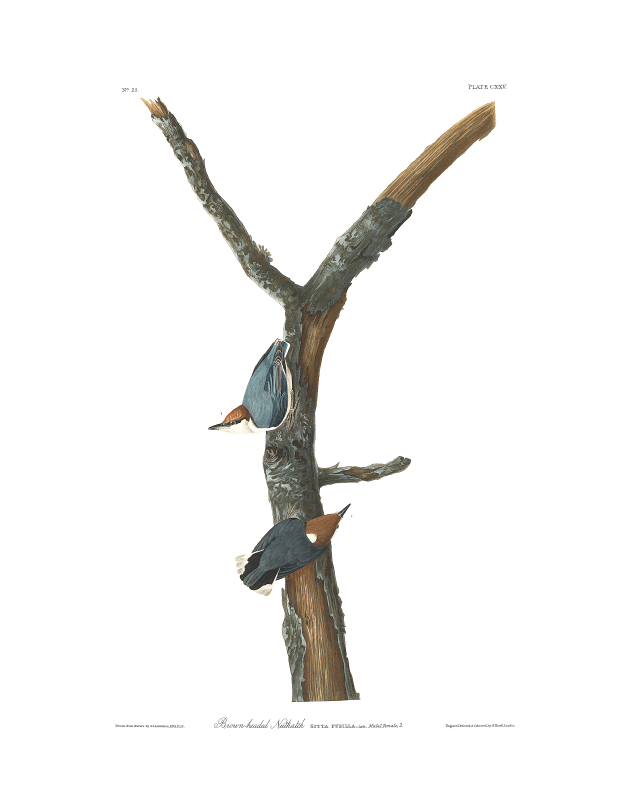|
Havell Name
Brown-headed Nuthatch Common Name Brown-headed Nuthatch Havell Plate No. 125 Paper Size 39" x 28" Image Size 18" x 10" Price $ 600 |
||||
|
Ornithological Biography Actively and most diligently employed is this little rover ever found in our pine woodlands of the Southern Districts, where it resides all the year, and beyond which it seldom extends, few being ever seen to the eastward of Maryland. Those large tracts of sandy soil that occupy the greater portion of the Floridas, Georgia, and the Carolinas, appear to suit its habits best. It is rather rare in Louisiana, and none go so far as Kentucky. It is the smallest species of Nuthatch as yet found in the United States. Its notes are several octaves above those of the White-bellied Nuthatch, more shrill, and at least one and a half above those of its northern cousin, the Red-bellied. Although fond of pine-trees and pine-barrens, it does not confine itself to these, but may not unfrequently be seen pursuing its avocations on lower trees and on fences, mounting, descending, turning in every imaginable position, and with a quickness of motion so much greater than that of most other birds as to render it extremely difficult to shoot at. It examines every bole and cranny of the bark of trees, as well as their leaves and twigs, on which it finds abundance of food at all seasons. During the breeding period they move in pairs, and are constantly chattering. Their notes resemble the syllables deut, deut, dend, dend, and although not musical are not disagreeable, particularly when heard in the woods in which they usually reside, and where at that season a mournful silence intimates the wildness of the place. When the young have left the nest they continue together, and move from tree to tree with the activity of their parents, who join them when the succeeding broods are able to find food for themselves. Towards winter they associate with the smaller species of Woodpeckers, the Brown Creeper, and the Southern Black-headed Tit. These birds pursue their avocations with so much cheerfulness that the woods echo to their notes. I have seen a congregation of these Nuthatches, amounting to fifty or more, thus perambulating the Floridas in the months of November and December. In those districts they pair in the beginning of February, and have eggs about the middle of that month, while in South Carolina they breed about a month later. The nest is usually excavated by the birds themselves, in the dead portion of a low stump or sapling, sometimes only a few feet from the ground, but not unfrequently so high as thirty or forty feet. The little creatures work in concert, with great earnestness, for several days, until the hole, which is round, and not larger at its entrance than the body of the bird, is dug ten or twelve inches deep, and widening at the bottom. The eggs are laid on the bare wood; they are from four to six, white, with reddish dots, and scarcely larger than those of the Humming-bird. They frequently raise three broods in the season, but more commonly two. Extremely careless in the presence of man, who indeed seldom molests them, they often peep at him when at the distance of only a few feet; yet when apprehensive of danger, they instantly fly off or ascend the tree, and are out of sight in a moment. Their flight is similar to that of the other species, and like them they frequently utter their notes while on the wing. Now and then they are seen on the ground, where they hop and turn over the dead leaves in search of their food, which consists entirely of insects and their larvae. The young of this species do not acquire the brown colour of the head until the approach of spring, when no difference is observable between the sexes. BROWN-HEADED NUTHATCH, Sitta pusilla, Wils. Amer. Orn., vol. ii. p. 105. SITTA PUSILLA, Bonap. Syn., p. 97. BROWN-HEADED NUTHATCH, Nutt. Man., vol. i. p. 584. BROWN-HEADED NUTHATCH, Sitta pusilla, Aud. Orn. Biog., vol. ii. p. 151. Male, 4, 8. From Texas to Maryland. In the interior to Mississippi. Extremely abundant. Louisiana, Georgia, Alabama, Florida, and the Carolinas. Resident. Adult Male. Bill of moderate length, strong, subconical, compressed, the tip abrupt and wedge-shaped; upper mandible slightly convex in the dorsal outline, the sides sloping, the edges acute; dorsal outline of lower mandible straight. Nostrils basal, lateral, oblong. General form short and robust. Feet rather short and strong; tarsus compressed, anteriorly scutellate, behind sharp; toes free, scutellate above, the hind toe strong; claws arched, compressed, acute, that of the hind toe large. Plumage soft and blended; wings of ordinary length, the second, third, and fourth quills longest. Tail short, even, of twelve rounded feathers. Bill brownish-black above, and on the tips of the lower mandible, the base of which is light greyish-blue. Iris hazel. Feet dusky brown. The general colour of the plumage above is dull leaden-grey; the two middle tail-feathers of the same tint; the rest black, the margin of the outermost and the ends of it, and of the three next on each side, white, the tips grey. Upper part of the head and hind-neck light reddish-brown, with a white spot on the hind-neck. The under parts in general are dull white. Length 4 inches, extent of wings 8; bill along the back 5/12, along the edge 7/12; tarsus 8/12. Adult Female. The female has the tints paler, but in other respects resembles the male. |
|||||
|
|
|||||


| Home | Gallery | Audubon Biography | About Edition | Testimonials | Authorized Dealers | Links | Contact Us |

© Copyright 2007-2024 Zebra Publishing, LLC. | All Rights Reserved Terms of Use
Powered by Fusedog Media Group
